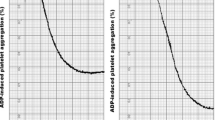Summary
Standard heparin as well as low molecular weight heparin (LMWH) increase lipid levels in serum. It has been reported that a diet rich in long chain saturated fatty acids can enhance the susceptibility to experimental thrombosis. The mechanism by which serum fatty acids may provoke thrombosis is not clear. It is possible that the fatty acids change the properties of the cell membrane and thereby modify the response of platelets to aggregating agents.
Heparin and its LMW fractions, by mobilising lipoprotein lipase that hydrolyses serum triglycerides (TG), cause the serum TG to increase, a well known ‘clearing effect’ of heparin in turbid lipemic plasma. This effect may have no significance when it lasts for a short time; however, a long-lasting heparin effect on TG serum levels may have important consequences.
The purpose of this study was to examine the time span of the action of heparin and its fractions and to investigate variations in the concentration of digoxin, which is a compound with narrow therapeutic width.
The investigated substances after 2 days administration, provoked serum concentration increases of free fatty acids (FFA), TG and HDL-C. Seven days after stopping drug administration. FFA and HDL-C levels remained high, while triglycerides declined. Serum total cholesterol remained unchanged throughout. Digoxin levels increased non-significantly after heparin administration and during swimming stress, while a lipid diet caused a serum digoxin concentration increase.
Similar content being viewed by others
References
Vukydis P.C., Granistas A.N., Varonos D.D., Nikitopoulou G.C. (1963): Die Wirkung wiederholter Heparinin-jektionen auf den Gesamtfett-und Cholesterinspiegel des Serums von gesunden Ratten. Klin. Wschr., 41, 928–930.
Tesserommatis C., Tsopanakis C., Varonos D.D. (1988): Changes in serum lipids with the presence of various factors. In: Treatment of Severe Hypercolesterolemia in the Prevention of Coronary Heart Disease. Vol. 23. Basel, Karger, pp. 195–197.
Renand S. (1968): Thrombogenicity and atherogenicity of dietary fatty acids in rat. J. Ather. Res., 8, 625–629.
Hornstra G., Lussenburg R.N. (1975): Relationship between the type of dietary fatty acid and arterial thrombosis tendency in rats. Atherosclerosis, 22, 499–503.
Markwardt F. (Hrsg.) (1971): Anticoagulatien, Handbuch exp. Pharmakologie, Band-XXVII. Berlin, Springer, pp. 410–417.
Allain C.C., Poon L.S., Chan C.S., Richmond W, Fu P.C. (1974): Enzymatic determination of total serum cholesterol. Clin. Chem., 20, 470–475.
Lopez-Virella M.F., Stone P., Ellis S., Colwell J. (1977): Cholesterol determination of high density lipoprotein separated by three different methods. Clin. Chem., 23, 882–884.
Storstein L., Janssen H. (1976): Studies on digitalis. VI. The effect of heparin on serum protein binding of digitoxin and digoxin. Pharmacol. Ther., 20, 15–23.
Walker J., Bialy G., Walker V., Sherman R., Eisinger R. (1987): Digoxin-like immunoreactive substance in chronic hemodialysis patients; effect on digitoxin radio immunoassay. Am. J. Nephrol., 7, 300–302.
Segalstad S., Kierulf P., Langseth-Maurique K., Storstein L. (1988): Free digoxin in normal and albumin-deficient serum as estimated by centrifugal ultrafiltration. Clin. Chem., 34, 766–767.
Lunn P.G., Austin S. (1983): Dietary manipulation of plasma albumin concentration. J. Nutr., 113, 1791–1802.
Author information
Authors and Affiliations
Rights and permissions
About this article
Cite this article
Tesserommatis, C., Tsopanakis, C., Symeonoglou, G. et al. How harmless is FFA enhancement?. European Journal of Drug Metabolism and Pharmacokinetics 21, 213–215 (1996). https://doi.org/10.1007/BF03189715
Received:
Issue Date:
DOI: https://doi.org/10.1007/BF03189715




